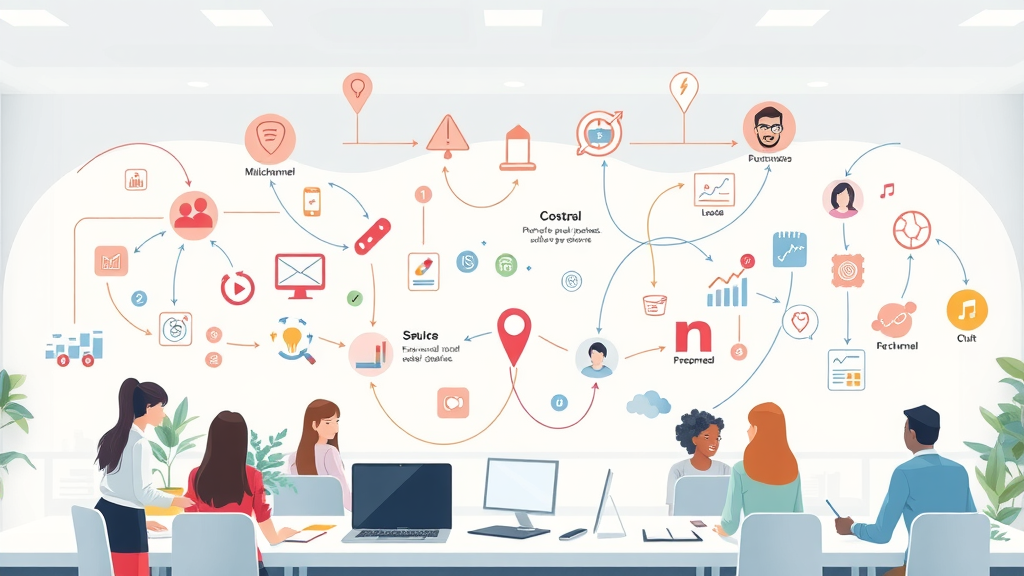Did you know that 73% of consumers use multiple channels before making a purchase? This eye-opening statistic unearths the reality that today’s omnichannel marketing isn’t a buzzword—it’s a must for survival in the current omnichannel market. If your omnichannel strategy is faltering, the root cause may be subtle yet costly mistakes you’re overlooking. In this in-depth guide, you’ll discover the most critical pitfalls, modernization secrets, and hands-on steps to ensure your omnichannel marketing strategy drives true business success. Don’t fall prey to common errors—let’s future-proof your customer journey together.

Startling Omnichannel Marketing Truths That Every Omnichannel Market Leader Must Know
For brands maneuvering the complex world of the omnichannel market , success means more than being present in multiple channels. Are you aware just how fractured a typical modern customer journey can be? Research shows nearly three-fourths of consumers interact with several touchpoints—including a mobile app , social media , email marketing , and physical stores—before finally deciding to buy. Missing even one critical link in your omnichannel approach risks driving shoppers to a more seamless competitor.
The new reality is that omnichannel marketing leaders don’t just enable customer movement between online and offline—they guide it. In a truly connected environment, every platform, from a brand’s digital marketing presence to in-store experiences, should offer unified data, consistent messaging, and smooth transitions. Failing to orchestrate this integration means opportunities—and revenues—are lost to brands who do. This makes it clear: investing in a robust omnichannel marketing strategy is fundamental for survival and growth in the evolving omnichannel market.
The Shocking Statistic: 73% of Consumers Use Multiple Channels Before Buying
As omnichannel customer behavior accelerates, overlooking multi-touch journeys is no longer an option. Most shoppers seamlessly switch between devices and channels, blending e-commerce with brick-and-mortar, social media , and even mobile apps before conversion. Brands poised to excel don’t just track this movement—they leverage it for an elevated omnichannel experience.
“Brands with strong omnichannel marketing strategies retain 89% of their customers on average compared to 33% for those with weak omnichannel engagement.”
Comprehensive Guide to Omnichannel Marketing: Foundations and Key Concepts
Definition and importance in the omnichannel market : Omnichannel marketing is a comprehensive, customer-centric strategy that unites all digital and physical channels to deliver a seamless experience.
The omnichannel approach: Uniting online and offline channels : Unlike multichannel marketing, omnichannel connects all marketing channels —from web and mobile app to physical stores —so your customers feel the same at every touchpoint.
Omnichannel marketing strategy vs marketing strategy basics : Traditional strategies treat each channel in isolation, but omnichannel considers the holistic customer journey and values every interaction.
Key role of customer journey in omnichannel experience : Mapping end-to-end customer behavior reveals where gaps or disconnects might exist and pinpoints new opportunities for engagement and loyalty.
Comparison: Omnichannel Marketing vs Multichannel Marketing vs Single Channel |
|||
Channel Type |
Customer Data Integration |
Channel Consistency |
Customer Experience |
|---|---|---|---|
Omnichannel |
Unified view |
High |
Seamless |
Multichannel |
Partial |
Moderate |
Fragmented |
Single Channel |
No |
Low |
Disconnected |

Crucial Omnichannel Marketing Mistakes: What Sabotages Your Omnichannel Market Opportunities?
Ignoring Customer Data: The Silent Killer of Effective Omnichannel Strategy
Ignoring customer data can be fatal to any omnichannel strategy . Many brands struggle to consolidate data from mobile apps , email marketing , and social media , leaving them blind to critical steps in the customer journey . This fragmentation leads to missed opportunities for personalization and a disconnected experience. Without unified insights, even the best-designed omnichannel campaign fails to resonate across touchpoints, eroding both trust and retention.
Overlooking customer journey mapping
Incomplete data between mobile app, email marketing, and social media
Examples from failed omnichannel campaigns
Consider the impact: one retailer launched an ambitious omnichannel marketing campaign but neglected to stitch together in-store and online behavioral data. The result was duplicate communications, conflicting recommendations, and a confused audience—a classic case of the silent killer sabotaging omnichannel market growth.

Overlooking the Digital Marketing Ecosystem: Online and Offline Channel Disconnect
One of the gravest mistakes in omnichannel marketing is treating online and offline as separate realms. When your marketing campaign messages, promotions, or loyalty programs differ between web and physical store, you send mixed signals—confusing customers and diluting your brand experience . A customer who discovers an exclusive online offer only to find it’s unavailable in-store feels let down, which erodes customer loyalty over time.
Failing to coordinate marketing campaigns across all platforms
Omnichannel experience gaps between in-store and online touchpoints
Brands that invest in synchronizing their digital marketing and physical experiences create a competitive edge. Cross-platform consistency is now a baseline expectation—not a differentiator. If your omnichannel strategy overlooks this, bridging the gap quickly is essential to boost customer engagement and satisfaction.
Inconsistent Brand Messaging Across Channels: A Major Omnichannel Strategy Pitfall
Inconsistencies in brand messaging across social media , mobile apps , and physical stores weaken trust and undermine your entire omnichannel strategy . When each marketing channel speaks a different language, customers struggle to recognize or relate to your brand, which can spell doom for long-term loyalty and omnichannel market dominance.
Content misalignment in marketing strategy
Omnichannel market consequences for brand trust
Studies show that 43% of consumers are quite likely to trust brands more who present a unified message over multiple channels while brands with consistent messaging realize as much as a 23% gain in revenues. A strong omnichannel marketing strategy hinges on meticulously aligned messaging. Every touchpoint—from an Instagram story to a store display—should reflect one coherent voice, reinforcing your values and promises. When this support is lacking, customer confidence wanes and competitors gain valuable ground.

Neglecting the Mobile App Factor in Your Omnichannel Approach
As mobile shopping grows, neglecting your mobile app drastically weakens any omnichannel marketing efforts. Apps are vital connectors between digital and real-world experiences, powering functionalities like in-store barcode scanning, digital coupons, or geo-location triggers. Overlooking app updates or missing cross-device integration means fewer opportunities for engagement and, ultimately, lower customer satisfaction.
Missed cross-device opportunities
Impact on customer satisfaction and retention
If your mobile touchpoints lag behind, today’s customers notice immediately. A clunky, underperforming app shatters the otherwise seamless experience, driving users to better-equipped competitors. Prioritizing mobile innovation is now a fundamental pillar of any modern omnichannel marketing strategy.

Optimize Your Omnichannel Marketing Strategy: Proven Steps For Success
Centralize Customer Data for a Unified Omnichannel Experience
The cornerstone of an effective omnichannel approach is centralizing customer data to create a unified customer view. With robust customer data platforms, marketers can map the complete customer journey across devices and channels, anticipating needs and personalizing experiences at every step.
Leveraging customer data platforms
Mapping the full customer journey for omnichannel campaigns
This level of integration empowers marketing teams to understand purchasing triggers, preferences, and pain points—fueling more targeted and effective marketing campaigns. Investing in data-driven systems ensures your omnichannel strategy delivers tailored experiences that delight and retain your audience.

Bridge Online and Offline Channels for Seamless Customer Journeys
The seamless blend of online and offline is where true omnichannel success unfolds. Real-world leaders in the omnichannel market are blending e-commerce platforms, robust mobile apps , and brick-and-mortar store insights into one cohesive experience. For instance, a customer can start a purchase online, check stock via the mobile app, and finalize the transaction in physical stores—never missing a beat.
Real-world examples: Blending e-commerce, mobile app, and brick-and-mortar insights
Key metrics to monitor omnichannel marketing performance
Measuring the success of these efforts means monitoring metrics like cross-channel conversion rates, customer retention, and average spend per journey. With each seamless customer experience, your omnichannel campaign builds deeper loyalty and superior satisfaction.
Maintain Brand Consistency Across Multichannel and Omnichannel Campaigns
Achieving effective brand consistency is essential in both multichannel marketing and omnichannel environments. Align content, imagery, tone of voice, and campaign objectives across every touchpoint—from the web and mobile to in-store marketing—so customers never experience brand confusion.
Aligning content and creative for a coherent omnichannel marketing message
Cross-team coordination tactics
This often requires marketing, design, sales, and customer service teams to work together closely. Frequent collaboration and shared platforms such as centralized brand guidelines ensure every campaign is a harmonious extension of your brand promise.

Harness Social Media and Email Marketing for Omnichannel Market Expansion
Social media and email marketing are powerful tools for orchestrating personalized, sustained engagement across the omnichannel market. By integrating messaging, promotions, and account-specific offers across digital channels, brands create an environment where customers feel valued regardless of touchpoint.
Integrating campaigns for sustained engagement
Personalization strategies via digital marketing channels
Digital marketing platforms offer advanced segmentation and personalization capabilities—use behavioral data from social media , website, and shopping behavior to serve dynamic, relevant content for each customer segment. When executed correctly, these strategies fuel a cycle of engagement, conversion, and ongoing customer loyalty.
The Four Pillars of Omnichannel Marketing: Building Your Omnichannel Market Framework
1. Integrated Customer Data
2. Consistent Messaging
3. Seamless Channel Integration
4. Continuous Optimization

“A true omnichannel approach creates an environment where the customer’s needs guide the journey.”
People Also Ask – Demystifying Omnichannel Marketing
What are the 4 pillars of omnichannel?

The four pillars of omnichannel marketing are: integrated customer data, consistent messaging, seamless integration of marketing channels, and continuous optimization. These interdependent components ensure brands create unified, personalized customer experiences across every touchpoint, from mobile app and social media to physical stores and email marketing. Mastering all four enables brands to stay agile and drive true omnichannel market success.
What is omnichannel marketing vs multichannel marketing?
Multichannel marketing focuses on reaching customers through several independent marketing channels—like email, social, and in-store—without necessarily connecting the experiences. Omnichannel marketing, on the other hand, synchronizes all platforms and data, creating a single, unified journey. The result is a cohesive customer experience that follows users wherever they interact with your brand.
What is an example of omni channel marketing?
A retailer allowing customers to browse products on their mobile app, make inquiries through social media, and collect their purchase in-store—while seamlessly tracking their preferences across all touchpoints—is practicing omnichannel marketing . This approach provides a truly connected, convenient, and personalized shopping experience that builds loyalty and satisfaction.
What is omnichannel marketing?
Omnichannel marketing is a strategy that unifies all digital and physical touchpoints to deliver seamless and consistent brand experiences. This involves integrating customer data, content, and messaging across mobile app , email marketing , social media , and physical stores, ensuring the customer feels recognized and valued at every stage of their journey.
Essential Omnichannel Marketing Tips to Avoid Common Mistakes
Use analytics to identify customer journey gaps
Segment audiences for relevant omnichannel campaigns
Invest in mobile app enhancements
Ensure every marketing strategy includes online and offline touchpoints
Value customer data for improved omnichannel experience
Expert Answers to Omnichannel Marketing FAQs
Q: How do omnichannel marketing strategies improve customer satisfaction?
A: They provide personalized, unified experiences that increase loyalty.Q: Is omnichannel marketing suitable for small businesses?
A: Yes, with the right tools and scaled approaches, even small brands benefit.Q: What metrics should I track for omnichannel campaigns?
A: Monitor customer retention, channel engagement, and cross-channel sales conversions.
Key Insights to Master Omnichannel Marketing and the Future of the Omnichannel Market
The omnichannel market continues to grow, demanding deeper integration
Customers expect seamless connectivity in every omnichannel campaign
Investing in technology and customer data analytics is vital for success

Take Your Next Step: Transform Omnichannel Marketing Mistakes into Lasting Success
Audit your customer journey, centralize your data, unify messaging, and empower every channel—your omnichannel marketing strategy is ready for its next breakthrough.
To deepen your understanding of omnichannel marketing and avoid common pitfalls, consider exploring the following resources:
Struggling to make All of your marketing strategies work together seamlessly and effortlessly? Click the Link and Get our Ultimate Guide for Building a Content Marketing Strategy for Small Business..
“Omnichannel Marketing: The Benefits And How To Get Started” ( forbes.com )
This article outlines the advantages of implementing an omnichannel strategy, such as enhanced customer experience, increased sales, and improved customer retention. It also provides practical steps to integrate data and technology for a seamless customer journey.
“Omnichannel Marketing: An In-Depth Guide” ( outbrain.com )
This comprehensive guide delves into the benefits of omnichannel marketing, including increased sales, enhanced customer loyalty, and a competitive edge. It offers insights into creating a unified customer experience across various channels.
By reviewing these resources, you can gain valuable insights into effective omnichannel marketing strategies and learn how to implement them successfully.
 Add Row
Add Row  Add
Add 




Write A Comment